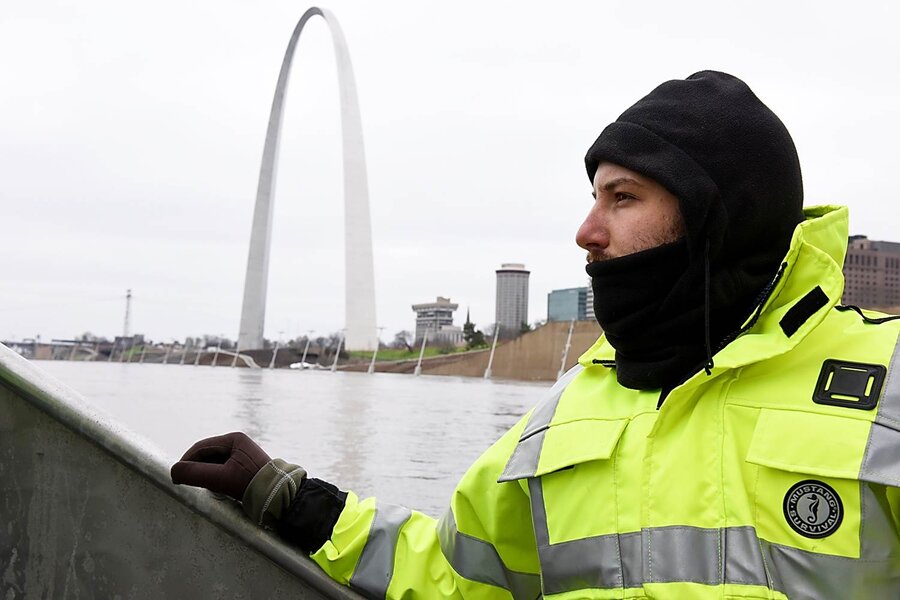Missouri communities work to weather unusual winter floods
Loading...
A rare winter flood across the Midwest has required resilience, from volunteer sandbaggers to Red Cross evacuation centers, and a network of 1,000 local, state, and federal officials are deploying a flood control plan – the $13 billion Mississippi River and Tributaries project.
Unusual flooding came in with the holidays for the Midwest and South, and hard-hit communities are still weathering the storm by applying lessons learned in past flooding episodes.
"Everybody is at battle stations," Bob Anderson, a spokesman for the Mississippi River Commission in Vicksburg, Miss., told The Christian Science Monitor on Thursday. "For a long time, they called it flood control, but since [Hurricane] Katrina the wiser heads said you can't really control the flood, you can only manage it."
The flooding topped the 1993 flood record in some places, which has challenged flood control efforts. As of Saturday, 11 levees failed, and at least 22 people have died in the floods, the Associated Press reported.
The immediate danger is now past for St. Louis and relief efforts have begun, but flooding could occur further down the Mississippi River in Tennessee, Mississippi, and Louisiana. Officials announced that most of the main roads and highways coming out of St. Louis reopened over the weekend, so commuters can return to post-holiday work in most cases.
Flood management during major floods in 2011 protected most communities and minimized damage to the 12.1 million Americans who live in areas with active flood warnings, Patrik Jonsson reported for The Christian Science Monitor:
The $13 billion Mississippi River and Tributaries project aims to regulate river flow from where the Ohio and Mississippi swirl into each other at Cairo, Ill., (pronounced "kay-ro") all the way to New Orleans. The MR&T is a complex series of backwaters, levees, spillways, floodways, fuse plugs, and control structures, like the one at Old River Control Complex, which have been known to tremble as they try to keep the river in its designated place.
Workers with the project are now trying to employ similar strategies as they continue to manage the floodwaters moving south. Flooding has damaged some homes in southeast Missouri, but flood control measures have helped in a few cases. The tiny town of Allenville, Mo., experienced the flood, but its residents are "used to being isolated and cut off" and began using boats to get around, the Chicago Tribune reported.
A flood wall protected most homes in Cape Girardeau, a community of 40,000. Although the Mississippi River damaged more than 20 homes, officials Saturday were "cautiously optimistic" that the flood wall had held back the worst of the flooding. The water level was already falling by Saturday morning, suggesting that a predicted crest on Sunday might not hit the city after all, KCTV reported.
In addition to the flood wall, the city of Cape Girardeau has spent years strengthening the nearby system of levees, and it has, with some federal money, bought out homes in the Mississippi River's flood plain, Nicholas J.C. Pistor reported for the St. Louis Post-Dispatch.
Missouri Sen. Roy Blunt (R) visited Cape Girardeau Friday to highlight the "really unique, long-term effort" against floods in the area, and he suggested similar tactics in the St. Louis area would be helpful going forward.
Cape Girardeau resident June Campbell watched the river move by from high ground, remembering how floods had incapacitated the town in past years, while they currently have left it relatively undamaged.
“It’s scary, I remember in the ’50s when the whole town was flooded,” she told the St. Louis Post-Dispatch. “Now we have the wall.”








